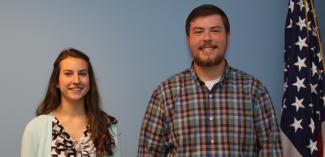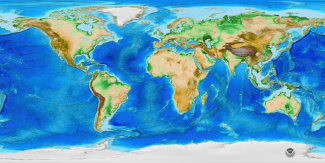
When people ask Vincent O’Leary what he did this summer, he can say he changed the way we see the world. This NOAA Ernest F. Hollings Scholar spent his summer internship with NCEI developing a global topographic relief model, a map that shows Earth’s solid surface, minus the water.
“I am developing an updated version of NOAA’s ETOPO1 global elevation model,” Vincent said. “The model will be used for a variety of other projects such as tsunami forecasting, ocean circulation modeling, visualization of the effects of climate change, and understanding tectonic activity.”
Vincent was one of three scholars to work at NCEI on projects and research. Rachel Phinney, a senior studying meteorology and computer science at the University of Nebraska, and Chase Graham, a senior atmospheric science major at the University of North Carolina at Asheville, also participated in the prestigious award program, both under the direction of the North Carolina Institute for Climate Studies (NCICS) through North Carolina State University.
Scholarship Alumni Help New Interns
Vincent’s job has been updating NOAA’s global elevation model using new datasets since the 2008 release of the current model created by a former Hollings Scholar. Bathymetric, shoreline, and topographic data contributed to the creation of ETOPO1. ETOPO’s name is derived from “earth topography.”
Scientist Chris Amante of NCEI and the Cooperative Institute for Research in Environmental Sciences (CIRES) mentored Vincent in Boulder. Chris originally developed the ETOPO1 model as a Hollings Scholar in 2008 and supervised this summer’s update.
Chris remembers: “The internship literally changed the trajectory of my life, as I have now been working as a scientist in Boulder for eight years. I was thrilled to have the opportunity to mentor Vincent and come full-circle from mentee to mentor.”
Vincent will be a senior at Drexel University in Philadelphia this fall, where he majors in environmental science and minors in geoscience and mathematics.
“Working with NCEI at Boulder has been a great experience, letting me contribute to the public through my research,” Vincent said.
Scientist Jared Rennie of NCICS, himself a Hollings Scholar in 2007, co-mentored Rachel and Chase. Their research projects focused on precipitation. She created visualizations and projections of local precipitation across the United States, and he studied patterns in tropical cyclone rainfall.
Hollings Scholars Program
The scholarship, begun in 2005 and named in honor of former U.S. Sen. Ernest F. Hollings of South Carolina, recognizes outstanding undergraduates studying in fields that support NOAA’s mission.
Each year, 120 undergraduate students receive tuition support as well as summer internship opportunities at NOAA facilities across the United States. The 10-week paid internship provides the scholars with hands-on, practical experience in NOAA-related science, research, technology, policy, management, and education activities. The culmination of their work is presented to leaders at NOAA and NESDIS.





